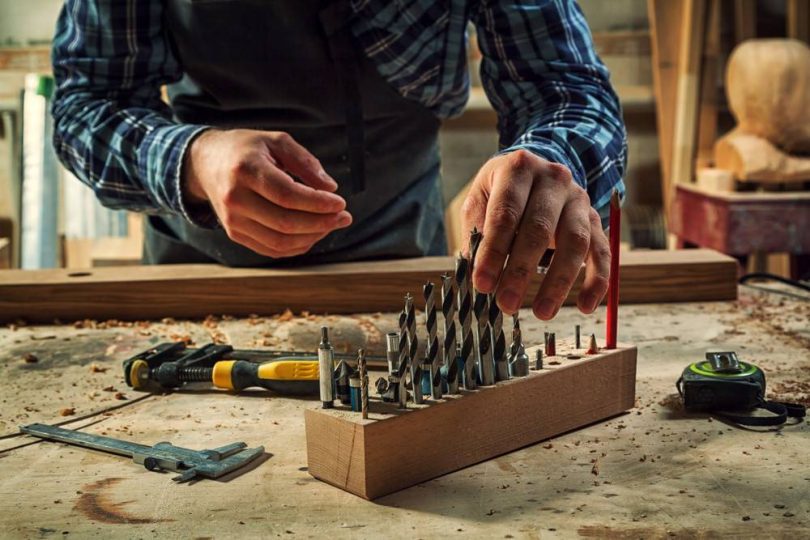You likely own a big drill or an old drill that never stops working if you are here. If you have misplaced the chuck key, which most of us do, fortunately, the drill bit can be changed without a chuck key, and we’ll show you how to get it done like a pro.
How to Change a Drill Bit Without a Chuck Key?
Method 1: Using a flat head screwdriver
Step 1: Gather tools
- Philips head screwdriver
Step 2: Place the screwdriver on the gears of the chuck
A Phillips screwdriver or a nail with a suitable diameter is commonly used. Place the chuck into one of the recesses, locking it in place. To open the chuck, twist the other half with your hand. Usually, unwinding is quite simple this way.
Step 3: Installing a new drill bit
Place your drill in the hole’s center and then turn the chuck to close it. Be sure the drill bit is fully inserted. The chuck must be rotated until the bit is securely attached and well centered.
Step 4: Verify the bit is correctly installed
Check to see that the bit is in place by lightly pressing the drill bit.
Method 2: Using a drill
Step 1: Gather tools
- Electric drill
Step 2: Rotate the drill
On the left side of the handle, you should see a button for controlling the drill. Pressing this button will cause the drill to spin in one direction.
Rotate the bit counterclockwse to remove it. By pressing the left side of the drill, you can rotate it anticlockwise.
Step 3: Hold the chuck
Drills have plastic chucks. Hold it with your free hand to prevent the chuck from spinning when you rotate the drill.
Tip: Use a wrench
For stuck drills, you can also unstick the chuck with a wrench. Whenever you use a wrench, it is important to take care as it could damage your drill.
Method 3: With pliers
Step 1: Gather tools
- Your drill
- A pair of quality pliers
Step 2: Remove the drill bit from the chuck and unlock it
The drill bit needs to go into a chuck keyholes (into the shank, not at the drilling section). If you don’t want to slash your hand, wrap a cloth around the bit.
Hold the bit there securely and grasp the chuck with the pliers. To prevent the jaws from ruining the chuck’s appearance, you can cover it with cloth or leather.
Step 3: Loosen the chuck by rotating it counter-clockwise
Try to keep the bit as still as you can while rotating the chuck in the opposite direction which will unlock it. The two can also be moved simultaneously if that feels better for you.
Doing this will cause the chuck to become loose. You can then pull the bit out.
Step 4: Attach the new drill bit
- Replace the bit with the new one, then lock it manually. Hold the drill bit in place as you turn the chuck. This will prevent the drill bit from falling out.
- The same process as before: the drill bit goes into a hole on the drill chuck and tighten the drill chuck by turning the pliers in a clockwise direction.
- You should be able to drill one hole, but if your drill is old make sure you tighten up the rest of the holes as well.
Step 5: Final examination
You should make sure the bit is centered properly before starting work. Then, start your drill to determine whether there is any shaking. If there is none, go ahead.
Method 4: Changing manually
Step 1: Loosen the chuck
You must first loosen the drill chuck before you can change the bit. Holding the handle in one hand and the chuck in the other is the best way to work with the chuck. Once it is loose, you can twist it counterclockwise. Another option is to pull lightly on the trigger.
Step 2: Disconnect the bit
The jaws that clamp the drill bit to the chuck will loosen when the chuck is loose, which makes removing the bit easy.
Step 3: Insert the bit
You should replace the bit with the one you wish to use in your drill. Pull the bit back as soon as it is inserted into the chuck, about one centimeter towards you. Make sure the bit is secure before you remove your finger and chuck, or the bit will fall out.
Step 4: Apply pressure to the trigger
For tightening the bit, firmly hold the bit and squeeze the trigger a few times. Make sure the bit is firmly in place.
Step 5: Activate the ratchet mechanism
Additionally, a ratchet mechanism may allow you to apply extra pressure to the bit’s shank. The mechanism works by rotating it firmly counter-clockwise close to the drill chuck.
Step 6: Examine the drill bit
After installing the bit, make sure that the bit is centered correctly before using it. Take your drill, pull the trigger a few times, and watch for wobbling. It will be obvious right away if the bit is not installed correctly.
Method 5: Using rubber rings for variable-speed hand drills
Step 1: Gather tools
- Rubber rings
Step 2:
The rubber rings are stretched over the chuck, giving you a good grip for tightening and loosening the chuck. If you own a newer drill, you might already have this installed.
Method 6: Create a new tool using a polymorph moldable plastic
Step 1: Gather tools
- Polymorph moldable plastic
- Heat gun
Step 2
Using a heat gun, melt the plastic.
Step 3
Quickly wrap it around the drill.
Step 4
The whole thing can be placed in the freezer when it is firm enough.
Step 5
If you wish to add a spanner or metal bar for extra leverage, add this in while it is still molten.
Step 6
Once it has been set, you are good to go.








